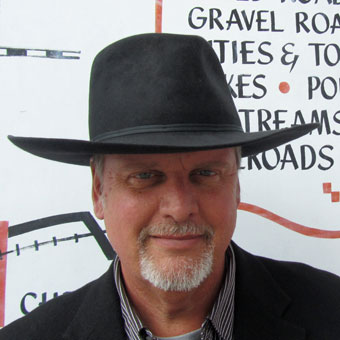
Michael Daugherty
To say that a composer's style is unique merely states what should be true of every composer, and yet when confronted with Michael Daugherty's music one feels compelled to make this claim. Enzo Restagno, Artistic Director of Settembre Musica in Torino, Italy has written:
"To observe The American landscape in Michael Daugherty's company is an unforgettable experience which I had during a long nocturnal walk through the streets of New York. Naturally we talked about music, but our talk was interrupted every minute because he kept stopping ecstatically outside a show window or some public building. He wanted to call my attention to some gadget or individual abounding in symbolic value. Clothing, menus, items for everyday use, gestures, posters, billboards, photographs, and architecture, all inspired lengthy observations endowed with great insight, but, at the same time, an affectionate irony. Like the energy that radiates from the icons housed in our European museums and art galleries, Michael Daugherty's music successfully releases the poetic power of American icons."
It is in part this fascination with the vernacular that sets Daugherty's music apart. By using sophisticated compositional techniques to develop his melodic motives combined with complex polyrhythmic layers, he has created a style that is bursting with energy and truly unique. Niagara Falls for symphonic winds will be the principal work considered here, though general background and performance considerations would apply to Desi and Bizarro for orchestral winds, Motown Metal for brass ensemble, Timbuktuba for euphoniums, tubas, and percussion, and UFO, Rosa Parks Boulevard and Red Cape Tango for symphonic winds.
Daugherty's connection to the pop world infuses his work at every level. The inspiration for much of his music comes from icons of the American pop culture. He acknowledges his debt to pop culture, saying:
"For me icons serve as way to have an emotional reason to compose a new work. I get ideas for my compositions by browsing through second book stores, antique shops, and small towns that I find driving on the back roads of America. The icon can be an old postcard, magazine, photograph, knick-knack, matchbook, piece of furniture or roadmap. Like Ives and Mahler, I use icons in my music to provide the listener and performer with a layer of reference. However, one does need the reference of the icon to appreciate my music. It is merely one level among many in the musical, contrapuntal fabric of my compositions."
The Metropolis Symphony and Bizarro are based on the Superman story; Desi is inspired by the television character Ricky Ricardo. One hears urban Detroit in the industrial sounding Motown Metal and the courage of an Afro-American civil rights icon in the emotional charged Rosa Parks Boulevard. UFO is inspired by the unidentified flying objects that have been an obsession in American popular culture since 1947.
Not surprisingly, Niagara Falls draws its inspiration not only from the falls themselves, but most importantly from the pop culture that surrounds this natural wonder.
"My parents went on their honeymoon and I've visited there many time as I have in-laws in Syracuse so we stop at Niagara Falls on the way. Niagara Falls is a destination for honeymooners and its also one of the biggest capitals of tourist traps in North America. I think that to even write a piece inspired by this sort of concept is still uncommon in concert music. Yet when I am writing the music I am extremely serious about putting the notes, the dynamics and the articulations, the timbre, the structure and the counterpoint. When I compose, I think in a very structural logical way as Webern and Bach did."
Daugherty's melodic material--usually short motives that are repeated in sequences or canons--frequently comes straight from jazz or Latin musical idioms with strong syncopation. Often the accompanying figures are rooted in big band jazz, whether the closely harmonized scale fragments typical of a saxophone section or the explosive interjections by the brass. All of this occurs over rhythmic ostinati or grooves in the bass and percussion sections--the classic rhythm section of pop and jazz.
-- Timothy Salzman
